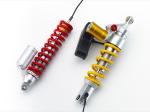BMW Semi-Active Suspension DDC
By Kevin Ash - 04/10/2012
BMW is the first company to announce semi-active suspension for motorcycles. The new system, called Dynamic Damping Control (DDC) will be appearing on 2012 models as the next logical step forward from the existing ESA II electrically adjustable suspension.
With ESA II the rider can choose from three basic settings, Comfort, Normal and Sport and the electric motors on the suspension units alter the damping and at the rear the spring rate accordingly. The rider can further modify these settings according to load, with additional combinations of two-up and luggage.
DDC also allows the rider choose between three modes, but rather than switching between fixed settings, the suspension is changed between three different maps.

The key difference comes in the semi-active element of DDC: the damping settings are changed automatically by computer according to how the bike is being ridden at any instant. When the bike is accelerating, the damping at the rear is increased while the front is reduced, to suit the rearward weight transfer. During braking the opposite happens, with increased front damping and reduced rear. In a corner, damping front and rear is increased to match the increase in g-force pushing down on the bike.
The level and extent of these changes as well as the steady speed settings depends on which mode has been selected. What the three basic modes do is move the boundaries of the adjustments being made by the computer.

There is considerable refinement to the basic idea. The DDC system has input from sensors measuring spring length and movement as well as from the ABS and traction control systems. If for example the traction control is intervening, the damping is adjusted to maximise grip in this situation.
In cornering, the damping is increased gradually, according to the lean angle of the bike, to compensate for the increased g-force, while in braking the change in damping is proportional to the braking force being applied. The damping also changes according to the road surface, adjusting to suit very bumpy roads for example.

The system has been enabled by the development of electrically activated proportional damping valves, which can change settings much faster than conventional valves. It takes only milliseconds to switch from one setting to another - without this speed of reaction the system could not work effectively.
The spring rate adjustment is not a part of the semi-active element of DDC, this is adjusted as in ESA II according to the base setting chosen by the rider. It isn't possible using existing technology to adjust the spring rate quickly enough for a semi-active system.

It is not yet clear which 2012 model or models will be fitted with DDC, but sports as well as touring bikes would benefit. The S1000RR is a clear candidate, especially as Ducati appears also to be working on a semi-active suspension system in conjunction with Öhlins for the new 1199 superbike. There will be clear benefits to the bikes‘ outright performance in terms of grip, braking and general handling which will be measurable in lap times.
But other bikes will also gain, and as BMW's illustration uses front and rear suspension struts rather than telescopic forks and strut, the likelihood is that DDC will appear first on a bike with Telelever or Duolever front suspension, meaning an R-series or K-series machine. On these, the damping can be reduced at steady speeds to improve ride quality, but increased in acceleration, cornering and braking to maintain stability, expanding the balance between comfort and handling.
The question now is, which manufacturer will get a semi-active suspension motorcycle into showrooms first, BMW or Ducati? Whoever it is, it‘s going to happen on a 2012 model.
Donate to the Kevin Ash Fund
Kevin's funeral was held on Thursday 28th February 2013 and was well attended by family, friends and colleagues.
The Telegraph has very kindly established The Telegraph Kevin Ash Fund to assist with the education of Kevin's three daughters.
If you'd like to make a donation then you can use the PayPal 'Donate' button below which will allow you to donate from your PayPal account, or via credit or debit card. A small percentage (about 3.4%) will be retained by PayPal for the service.
Kevin's family have been touched by the generosity and messages of support from people using the website and would like to express their gratitude to those who have contributed in any way.
The donations keep coming in, thank you so much, and the family especially like it when you leave a message.
Home | ![]() facebook.com/KevinAshFund
|
facebook.com/KevinAshFund
| ![]() twitter.com/KevinAshFund | © 2012
twitter.com/KevinAshFund | © 2012